I've been mulling over ideas for a guitar that I have decided I need in order to reproduce in a live situation the music I have been making in a couple of projects.
This past year I have taken to the bass guitar in a big way, so much so that it has become my main instrument. However, I still want to play guitar as well, but more than that what I'd really like to do would be to play both bass and guitar on the same songs. So, what is required is a doubleneck guitar and bass. Add in a looper pedal (or preferably two) and the possibilities are quite staggering - just check out what Kristian Dunn does in El Ten Eleven (see video clip above).
However, finding an off-the-shelf solution to a doubleneck guitar/bass combination is not so easy. Most such instruments I can find have the bass neck at the top and the guitar neck at the bottom. I can understand the logic at work here so that you have the strings across the entire instrument running from low to high, but I believe that this is not the best practical arrangement. Just think about it. For starters I'd have thought that having the longer bass neck at the bottom of the instrument would allow for better balance. But there is also the question of playability. With a bass on top you would need to rest your forearm across the longer scale bass strings in order to reach the guitar side, which could lead to unwanted damping or spurious noises from the bass if the volume for both necks was on at the same time. Also, for chordal work / strumming on the guitar I'd rather have that higher up on my body, whereas for playing bass I'm personally happier to have it slung a little lower.
So, yes, for me bass on bottom is definitely the way to go.
In which case, what options are there?
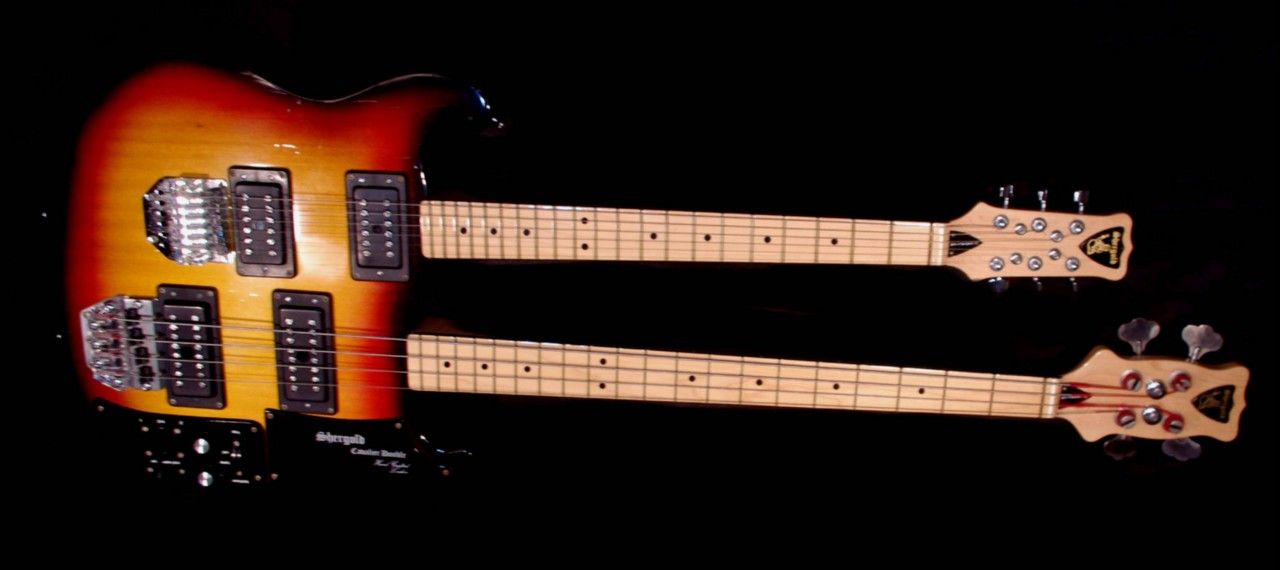
Well first off there are vintage instruments like the Shergold doubleneck and Danelectro examples pictured here.
Even better would be the Carvin DB630 as used by El Ten Eleven's Kristian Dunn. It's definitely one of the better doubleneck designs I have seen; it looks a lot less cumbersome than most.
Alas, these vintage instruments are all quite rare and not very easy to track down. In the event of actually finding one for sale, it is liable to be expensive. Did I mention that my budget is limited on this project? Quite frankly, the less I can get away with spending, the better.
OK, so how about a cheaper instrument from China or Korea? There are a number of websites that feature such instruments for sale, some of which have very cheeky copies of certain big brand American guitars complete with counterfeit logos, whilst others are variations on designs from those same companies but are guitars that never existed. In this latter category are a number of doublenecks.
For example, this Rickenbacker 6+4. (Note that Rickenbacker's own 4080 doubleneck model had the necks the other way around with the bass on top). However, even though the Far-Eastern made Rickenbacker-influenced doubleneck has the necks in the correct formation for my requirements, just look at the size of that thing! It's much more cumbersome than I would prefer.
I also found this Steinberger-like headless doubleneck 6+4. With a compact body and no headstocks it shouldn't be too cumbersome. However, I could find zero information about it and looking at the photos I couldn't tell if if had one output or two (that would be ideal - an output for each neck). Looking at the control layout, I can't see any selector switches, not just for the pickups but for each side of the instrument. The use of volume controls alone would not be convenient - you'd have to raise the volume on one side of the instrument and lower it on the other. A simple switch is what is required. Furthermore, when wondering how well it would balance on a strap, I checked all the photos I could find and couldn't even see any strap buttons. It does look to be a very cheaply made instrument. Yes, I wanted cheap, but even so I would prefer to have all the basic hardware you'd expect.
The only other doubleneck 6+4 that I could find (that is, with the guitar uppermost and the bass beneath) was this Strat/P-Bass combination. I liked this design very much and particularly liked the reverse headstock on the bass side which neatly gets around the problem of the tuners getting in the way of the opposite neck. Maybe it's a little more cumbersome than I should be aiming for, but it would indeed look very cool on stage. However, it appears to be a discontinued model and I simply couldn't find an example for sale. Quite frustrating.
OK, other options would be to commission a custom-built instrument but I've already explained that this is a budget operation, so that leaves the DIY route. Well, I've checked the doubleneck guitar kits available and can only find a 6+4 with the bass on top.
Bertram's advice to me is "try my way - cut two Squiers in halves and have them glued together by a pro." He's referring of course to his Doppelcaster, the doubleneck Telecaster that he built.
That is indeed one option, but if I wanted a doubleneck like the last one pictured above, joining a Strat body to a P-Bass body isn't quite so simple as the latter is a longer shape (remembering that I want the bass at the bottom). Then of course there is the body contouring to take into consideration. Slab-bodies would join together much more easily so maybe as Bertram suggests I should think Telecaster rather than Stratocaster.
Other guitars I considered joining together are:
- Ibanez GAX30 guitar and Ibanez GAX150B bass. But what do you know?... The GAX150B is now discontinued and no-one seems to be selling them on eBay either.
- Hofner Shorty guitar and Hofner Shorty bass. I thought this might allow for a nice compact design but I couldn't quite work if it was feasible to chop portions of the bodies off and join then together. There didn't seem to be quite enough material to work with. I did momentarily toy with the idea of NOT chopping down the bodies but connecting the two together with metal rods drilled into the bodies. However, I figure this would mean that the two necks would be too far apart from one another.
- Epiphone LP Junior/Special and similar bass. As long as both were slab-bodied and of the same thickness, this could work, but I simply haven't found the necessary donor guitars for sale.
So now I'm going to be rather cheeky and ask if there are any Guitarz readers out there who would be willing to help me with this project? (Hey, I may as well take advantage of having this guitar blog!) I neither have the resources or the talent so I'm going to ask: Would someone out there be able to build me a doubleneck body? I'm more interested in function rather than it being a superb piece of first class luthiery. Obviously I'd be willing to pay but I'm not able to pay custom shop prices. It'd probably be best if it was someone in the UK or maybe Europe, so as to minimize the cost of sending parts and materials back and forth.
I am open to suggestions but at the moment, I believe what is required is a new body routed for Telecaster parts on the guitar side and probably a P-Bass on the bass side (or possibly a Squier Bronco bass - the shorter scale may make for a better balanced instrument). As to the design, that is something we could discuss further.
Please contact me by email (gavinlloydwilson@yahoo.com) or else via the comments below.
If anyone else has any ideas which might be useful please feel free to add to the discussion.
Thanks
G L Wilson
Additional: Someone has suggested that I simply buy one of these and swap the necks around. I wonder if it might be as simple as that? I can see that the bridges and pickups are in the same positions but would the neck pockets be the same size?
© 2014, Guitarz - The Original Guitar Blog - the blog that goes all the way to 11!
Please read our photo and content policy.

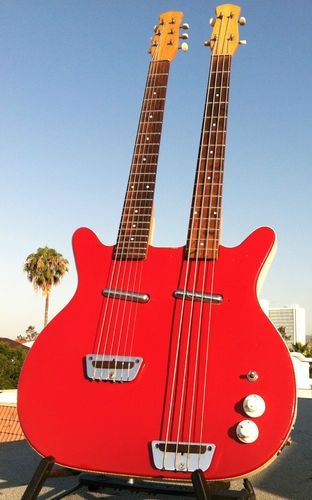
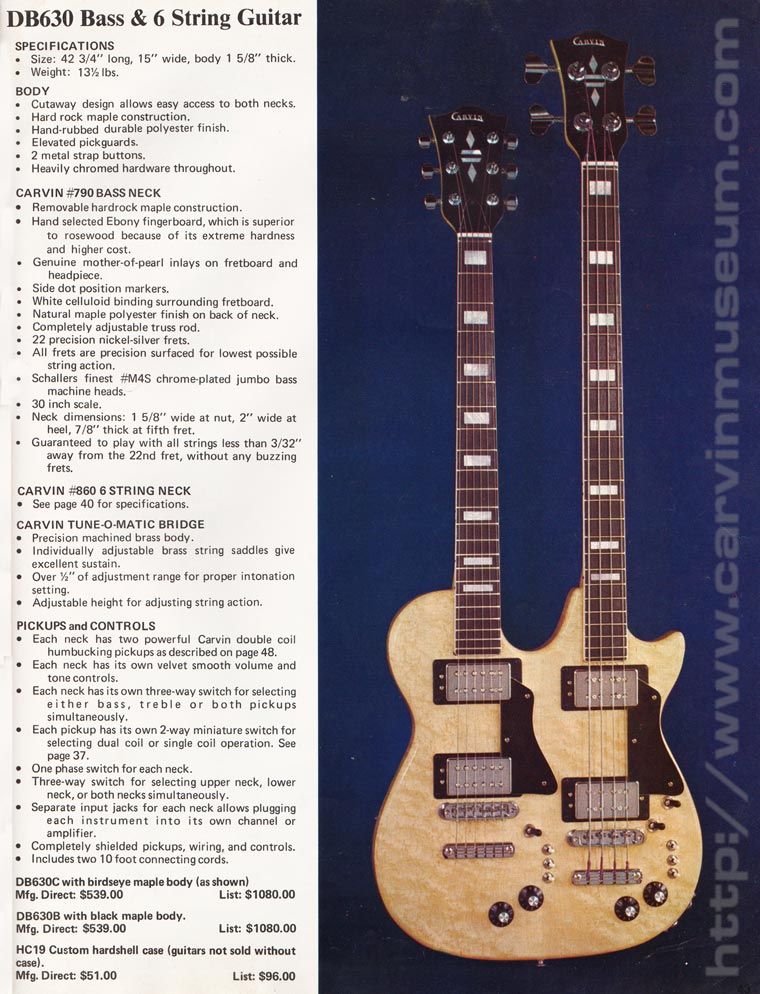
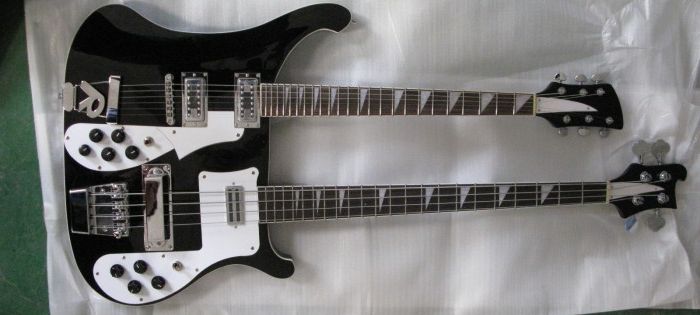
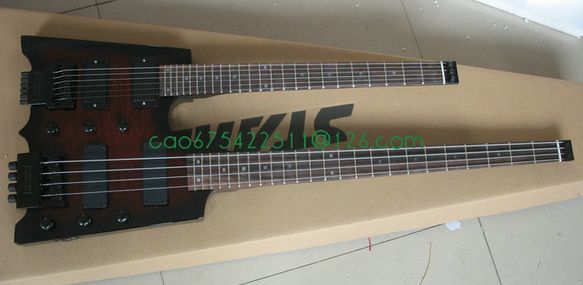
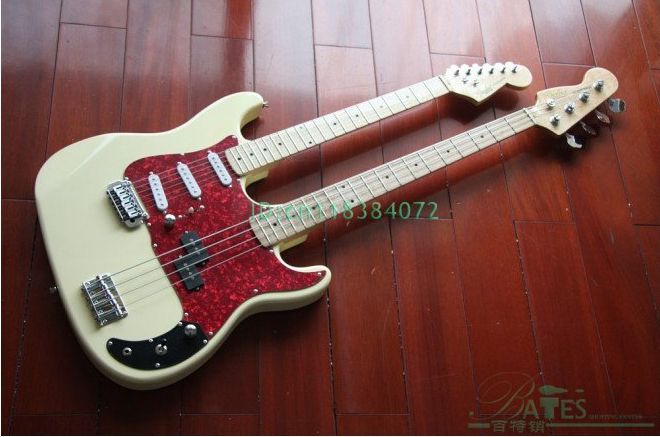

Why not get one of these left handed and flip it over? http://www.warmoth.com/Guitar/Bodies/DoubleBodyBuilder.aspx?style=33
ReplyDeleteAt Warmoth's prices it would be a very expensive compromise.
DeleteCheap cheerful made from parts sounds like a job for me :-D
ReplyDeletehttp://www.shonkymusicalinstruments.co.uk/home
You are probably right. What do you think would be the best way to go? Use a donor guitar and bass and build a new body or join together the bodies of the two donor instruments and refinish? We should discuss this some more.
DeleteHere's a homemade 6+4 constructed from two Burns Flytes:
ReplyDeletehttp://burnsguitarmuseum.blogg.se/2011/march/10-fakes.html#comment
I like that very much. Was that built from the re-issused Flytes (which the cutaways on the body would suggest) or the original Flytes (which the very pointy headstocks would suggest)? Flytes are rare beasts, so as much as I love this I don't think I'll go this route. Thanks!
Deletewhile I love (and lust after) A good dano as much as anyone, I think the cumbersome nature of a dano is itself a problem. Also, just how versatile is the dano tone? I'm no tone whore, but it is a very... unique sound, will it always work for you? I know you are able to wire up a guitar, do your own setups, even drill the necessary additional holes, but actual routing I think is beyond most of us. So the solution needs to be the easiest for you.
ReplyDeleteTo come back to warmoth, the double body (whilst not ideal) costs 329$ US in standard spec w/ no finish. This is expensive but is also possibly the single most expensive part (depending on the quality of the necks you choose) and is the bit which needs to be the highest quality. Keep in mind though, if you wanted to build a new bass and guitar, you would spend more on two separate similar quality bodies easily. So perhaps the cost of the body must always been seen as two bodies discounted. Goinf too cheap on the body may result if far more unplayble instrument than cheaping out anywhere else might; everything else can always be replacec over time; why not have a good body to bolt it all onto.
Another warmoth option is this http://www.warmoth.com/Guitar/Bodies/BodyBlank.aspx which is just a body with neck pocket and pickup routs (cost 118$ unfinished standard spec), so the harder bits are already done. All you have to do is cut and shape, so the only thing it's costing you is time. You may also be able to convince them to sell you a bass body blank as well, I can't see why they wouldn't. At least the body black allows you to customise with ease, rather than have to find two perfectly matched bodies.
With regard to necks, second hand is always a good option, but if you aren't intending to take this on a 90 date international tour, you might be able to get away with the cheap Mighty mite necks, they're at least as good as most cheap unbvranded Chinese necks.
Hopefully this might help!
Hi Steve, thanks for your input.
DeleteSo the Warmoth body is $329 you say. Then hike up the price more to get Warmoth to make a custom version with the necks the correct way around, Hike it again for shipping to the UK, and hike it a third time for import duties. All that is before it even gets any finish on it. It's going to be too expensive for me.
Especially when there are people here in the UK who can do the same thing for me.
I was taking it as read that the standard spec (perhaps L/h) would be enough. I have bought parts from them before and the postage costs was not especially extortionate.... Especially considering I live in Australia. And warmoth are a good example of what the cost might be, and another thing to consider is that they are a company who do this every day, thye might charge less than a much smaller outfit otherwise would be forced to charge.
DeleteJust out of curiosity, have you settled upon a pickup configuration, ideal or otherwise?
I looked some designs and think that if the necks are at slight "V" angle you could make the body plank lighter smaller, and when changing neck just rotate your axe by sliding the guitar strap a bit. Short scale headless bass neck may be least heavy, but dont know where you could find one. Maybe you could just cut off the head from cheapo short maple neck and bolt some string holder
DeleteThis comment has been removed by the author.
ReplyDeleteThe mad scientist is loathe to admit this, but buying the Dano and switching the necks would probably be the easiest option. The beautiful thing about Dano's is they're essentially made of chewing gum and tape. Any modifications should be pretty easy, considering the body is made of plywood. Just some shimming and shaving. I bet the pickups are the same on both necks. God bless Danelectro.
ReplyDeleteNow, here's my mad scientist idea. It would be a pretty serious undertaking, but a great opportunity to develop your lutherie skills, something I think is important for all guitar players. Plus, depending on the gig, I think this could be the best sounding option.
Let me summarize it thusly; http://i1375.photobucket.com/albums/ag455/apolicious1/DSCF0858_zps47d1d5cb.jpg
First off, yes, that is a terrible picture. I also couldn't find enough stable, stackable stuff to get the lap steel where I wanted it. But I think the idea has several advantages:
• Lap steels are typically just slabs with electronics and strings. That saves half the... halving right there. Any contouring on the bass would be lopped off, and you'd have two flat sides to pair.
• Many - especially older - steels were built with frets. Ornamental in nature, but functional. If you're going to play slide, this is a non-issue entirely.
• If you want dual outputs, both sides would be pre-wired.
• Vintage lap steel pickups sound really, really cool. Check out the "Coodercaster." Ry freely admits that even though it has a very desirable gold-foil pickup, it sounds nowhere near as good as the Oahu in the bridge.
• They're cheap as all getout. The steel pictured is a mid-50's Silvertone (or Supertone, if the name turns you off,) that I paid $60 for, but can easily be found around $200 in mint condition.
• Extended range. Eight string steels are just as easy to come by as six strings. Depending on the tuning, this could reduce the time spent switching between necks. Their pickups also offer an extended frequency range, which can yield some pretty neat tones.
• Did I mention they're crazy cheap?
Now, for the cons, of which there are many:
• Square necks. Round-necked lap steels basically don't exist. Many older models - including my own - have hollow necks, especially if they're made out of bakelite. Newer models typically have solid wood necks, which can be shaved down. That's a fair amount of work. But, again, I'm a big advocate of learning through trial and error.
• No truss rod. No way around that, really. They just don't come with truss rods. You can have one installed, but then we're wandering into the totally not worth it territory.
• Zero-radius fingerboard. Even if your donor steel has frets, the fretboard will still be flat. This would be especially problematic if you opt for an eight string. While great for tapping, it could make conventional chords awkward. I personally prefer this, but I'm a bass player, so take that with a grain of salt. If you wanted to get serious about it, you could buy a pre-radiused wood blank and fret it yourself - or even a premade fretboard - but that ranges from $20 - $100, and that'll take some serious gluing skills.
• Action. Put simply, it'll be too damn high. Replacing the nut should be no big deal, but you may have to route the body a bit to lower the pickup. And that requires a router. And those are expensive. (also a b*tch to use.)
Theoretically, you could slice the neck off the steel at [math content redacted] depending on a conventional donor neck. But now you're just getting showy. Also, steels tend to be a bit wider than standard electrics, so while the pickup would work (fantastically,) making a new neck pocket would be nigh-impossible. My inspirational template would be that tele mandolin you posted a while back. Just picture a bass, with a guitar neck growing out of it.
Anyways, that's my rant. p sure ambien took over at the end, but it's fall, it's raining, and I want to get my hands dirty.
bolt two guitars together their bodies overlaping - cheep fast and functional
ReplyDeleteSand down the connecting surfaces a bit, add glue, recess the bolts, and I think this guys got it!
DeleteTwo bodies bolted together is going to be too cumbersome. That approach isn't for me.
DeleteOK, thanks for your suggestions, folks. I've found my guitar builder and we are designing the doubleneck together. Keep tuned for more info as and when available!
ReplyDeleteUpdate? I'm in the same boat
ReplyDeleteHow did this end up?
ReplyDeleteOkay, as im after building one too, how did it turn out 4 years later.
ReplyDelete